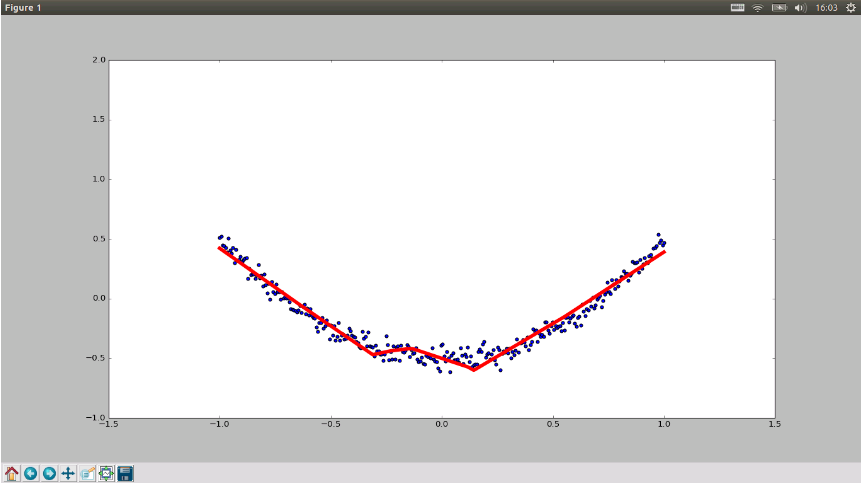您好,登錄后才能下訂單哦!
您好,登錄后才能下訂單哦!
小編給大家分享一下tensorflow如何建立一個簡單的神經網絡,相信大部分人都還不怎么了解,因此分享這篇文章給大家參考一下,希望大家閱讀完這篇文章后大有收獲,下面讓我們一起去了解一下吧!
如何添加一層網絡
代碼如下:
def add_layer(inputs, in_size, out_size, activation_function=None): # add one more layer and return the output of this layer Weights = tf.Variable(tf.random_normal([in_size, out_size])) biases = tf.Variable(tf.zeros([1, out_size]) + 0.1) Wx_plus_b = tf.matmul(inputs, Weights) + biases if activation_function is None: outputs = Wx_plus_b else: outputs = activation_function(Wx_plus_b) return outputs
注意該函數中是xW+b,而不是Wx+b。所以要注意乘法的順序。x應該定義為[類別數量, 數據數量], W定義為[數據類別,類別數量]。
創建一些數據
# Make up some real data x_data = np.linspace(-1,1,300)[:, np.newaxis] noise = np.random.normal(0, 0.05, x_data.shape) y_data = np.square(x_data) - 0.5 + noise
numpy的linspace函數能夠產生等差數列。start,stop決定等差數列的起止值。endpoint參數指定包不包括終點值。
numpy.linspace(start, stop, num=50, endpoint=True, retstep=False, dtype=None)[source] Return evenly spaced numbers over a specified interval. Returns num evenly spaced samples, calculated over the interval [start, stop].

noise函數為添加噪聲所用,這樣二次函數的點不會與二次函數曲線完全重合。
numpy的newaxis可以新增一個維度而不需要重新創建相應的shape在賦值,非常方便,如上面的例子中就將x_data從一維變成了二維。
添加占位符,用作輸入
# define placeholder for inputs to network xs = tf.placeholder(tf.float32, [None, 1]) ys = tf.placeholder(tf.float32, [None, 1])
添加隱藏層和輸出層
# add hidden layer l1 = add_layer(xs, 1, 10, activation_function=tf.nn.relu) # add output layer prediction = add_layer(l1, 10, 1, activation_function=None)
計算誤差,并用梯度下降使得誤差最小
# the error between prediciton and real data loss = tf.reduce_mean(tf.reduce_sum(tf.square(ys - prediction),reduction_indices=[1])) train_step = tf.train.GradientDescentOptimizer(0.1).minimize(loss)
完整代碼如下:
from __future__ import print_function
import tensorflow as tf
import numpy as np
import matplotlib.pyplot as plt
def add_layer(inputs, in_size, out_size, activation_function=None):
# add one more layer and return the output of this layer
Weights = tf.Variable(tf.random_normal([in_size, out_size]))
biases = tf.Variable(tf.zeros([1, out_size]) + 0.1)
Wx_plus_b = tf.matmul(inputs, Weights) + biases
if activation_function is None:
outputs = Wx_plus_b
else:
outputs = activation_function(Wx_plus_b)
return outputs
# Make up some real data
x_data = np.linspace(-1,1,300)[:, np.newaxis]
noise = np.random.normal(0, 0.05, x_data.shape)
y_data = np.square(x_data) - 0.5 + noise
# define placeholder for inputs to network
xs = tf.placeholder(tf.float32, [None, 1])
ys = tf.placeholder(tf.float32, [None, 1])
# add hidden layer
l1 = add_layer(xs, 1, 10, activation_function=tf.nn.relu)
# add output layer
prediction = add_layer(l1, 10, 1, activation_function=None)
# the error between prediciton and real data
loss = tf.reduce_mean(tf.reduce_sum(tf.square(ys - prediction),
reduction_indices=[1]))
train_step = tf.train.GradientDescentOptimizer(0.1).minimize(loss)
# important step
init = tf.initialize_all_variables()
sess = tf.Session()
sess.run(init)
# plot the real data
fig = plt.figure()
ax = fig.add_subplot(1,1,1)
ax.scatter(x_data, y_data)
plt.ion()
plt.show()
for i in range(1000):
# training
sess.run(train_step, feed_dict={xs: x_data, ys: y_data})
if i % 50 == 0:
# to visualize the result and improvement
try:
ax.lines.remove(lines[0])
except Exception:
pass
prediction_value = sess.run(prediction, feed_dict={xs: x_data})
# plot the prediction
lines = ax.plot(x_data, prediction_value, 'r-', lw=5)
plt.pause(0.1)運行結果:

以上是“tensorflow如何建立一個簡單的神經網絡”這篇文章的所有內容,感謝各位的閱讀!相信大家都有了一定的了解,希望分享的內容對大家有所幫助,如果還想學習更多知識,歡迎關注億速云行業資訊頻道!
免責聲明:本站發布的內容(圖片、視頻和文字)以原創、轉載和分享為主,文章觀點不代表本網站立場,如果涉及侵權請聯系站長郵箱:is@yisu.com進行舉報,并提供相關證據,一經查實,將立刻刪除涉嫌侵權內容。